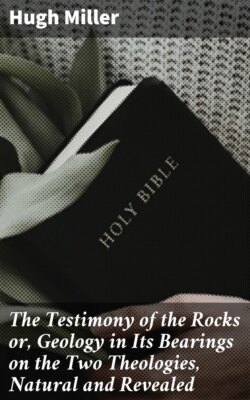Читать книгу The Testimony of the Rocks or, Geology in Its Bearings on the Two Theologies, Natural and Revealed - Hugh Miller - Страница 11
На сайте Литреса книга снята с продажи.
LECTURE SECOND.
ОглавлениеTable of Contents
THE PALÆONTOLOGICAL HISTORY OF ANIMALS.
Amid the unceasing change and endless variety of nature there occur certain great radical ideas, that, while they form, if I may so express myself, the groundwork of the change—the basis of the variety—admit in themselves of no change or variety whatever. They constitute the aye-enduring tissue on which the ever-changing patterns of creation are inscribed: the patterns are ever varying; the tissue which exhibits them for ever remains the same. In the animal kingdom, for instance, the prominent ideas have always been uniform. However much the faunas of the various geologic periods may have differed from each other, or from the fauna which now exists, in their general aspect and character, they were all, if I may so speak, equally underlaid by the great leading ideas which still constitute the master types of animal life. And these leading ideas are four in number. First, there is the star-like type of life—life embodied in a form that, as in the corals, the sea-anemones, the sea-urchins, and the star-fishes, radiates outwards from a centre; second, there is the articulated type of life—life embodied in a form composed, as in the worms, crustaceans, and insects, of a series of rings united by their edges, but more or less moveable on each other; third, there is the bilateral or molluscan type of life—life embodied in a form in which there is a duality of corresponding parts, ranged, as in the cuttle-fishes, the clams, and the snails, on the sides of a central axis or plane; and fourth, there is the vertebrate type of life—life embodied in a form in which an internal skeleton is built up into two cavities placed the one over the other; the upper for the reception of the nervous centres, cerebral and spinal—the lower for the lodgment of the respiratory, circulatory, and digestive organs. Such have been the four central ideas of the faunas of every succeeding creation, except perhaps the earliest of all, that of the Lower Silurian System, in which, so far as is yet known, only three of the number existed—the radiated, articulated, and molluscan ideas or types. That Omnipotent Creator, infinite in his resources—who, in at least the details of his workings, seems never yet to have repeated himself, but, as Lyell well expresses it, breaks, when the parents of a species have been moulded, the dye in which they were cast—manifests himself, in these four great ideas, as the unchanging and unchangeable One. They serve to bind together the present with all the past; and determine the unity of the authorship of a wonderfully complicated design, executed on a groundwork broad as time, and whose scope and bearing are deep as eternity.
The fauna of the Silurian System bears in all its three great types the stamp of a fashion peculiarly antique, and which, save in a few of the mollusca, has long since become obsolete. Its radiate animals are chiefly corals, simple or compound, whose inhabitants may have somewhat resembled the sea-anemones; with zoophites, akin mayhap to the sea-pens, though the relationship must have been a remote one; and numerous crinoids, or stone lilies, some of which consisted of but a sculptured calyx without petals, while others threw off a series of long, flexible arms, that divided and subdivided like the branches of a tree, and were thickly fringed by hair-like fibres. There is great variety and beauty among these Silurian crinoids; and, from the ornate sculpture of their groined and ribbed capitals and slender columns, the Gothic architect might borrow not a few striking ideas.
